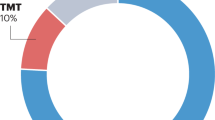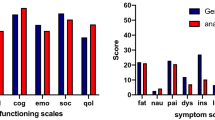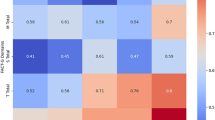Abstract
Health-related quality of life (HRQOL) in patients with bladder cancer is important, because radical cystectomy and urinary diversion significantly affect urinary and sexual function, and lead to associated sex-specific morbidity. This article reviews the current methods for defining HRQOL, describes the specific challenges in measuring HRQOL in patients with bladder cancer, and critically analyzes the existing literature on bladder cancer HRQOL. Previous studies have been limited by study design, generalizability, and by the different instruments used, namely nonvalidated questionnaires that are not specific for bladder cancer. To date, only two prospective studies with baseline HRQOL data have been published and few conclusions can be drawn from these cross-sectional, retrospective studies. On the basis of the published literature, there is no convincing evidence that superior HRQOL is achieved with a particular type of urinary diversion after cystectomy for bladder cancer. Patients should be counseled on all reconstructive alternatives and a diversion chosen on the basis of patient preference, patient anatomy and tumor status, rather than on a potential difference in HRQOL. Prospective studies with appropriate adjustment for confounding factors, which use validated and disease-specific questionnaires, are needed for HRQOL research on bladder cancer.
Key Points
-
At present, there are no convincing data that a particular urinary diversion technique is associated with superior health-related quality of life (HRQOL) after cystectomy
-
Most published studies of HRQOL after cystectomy are limited by their cross-sectional, retrospective design and lack of baseline data
-
To capture the sex-specific effects on urinary and sexual function and levels of bother experienced by patients who have undergone cystectomy in a single questionnaire is a difficult task
-
The Functional Assessment of Cancer Therapy Bladder Cancer questionnaire, the European Organization for Research and Treatment of Cancer Quality of Life Core Questionnaire for Muscle Invasive Bladder Cancer, and the Functional Assessment of Cancer Therapy—Vanderbilt Cystectomy Index are bladder-cancer-specific instruments that are currently being validated
-
Prospective studies with appropriate adjustment for confounding factors, and the use of validated and disease-specific questionnaires are needed in HRQOL research on bladder cancer
This is a preview of subscription content, access via your institution
Access options
Subscribe to this journal
Receive 12 print issues and online access
$209.00 per year
only $17.42 per issue
Buy this article
- Purchase on Springer Link
- Instant access to full article PDF
Prices may be subject to local taxes which are calculated during checkout
Similar content being viewed by others
References
American Cancer Society, Inc. (online 8 August 2006) Bladder Cancer Statistics [http://www.cancer.org] (accessed 26 January 2007)
Clark PE (2002) Urinary diversion after radical cystectomy. Curr Treat Options Oncol 3: 389–402
Krupski T and Theodorescu D (2001) Orthotopic neobladder following cystectomy: indications, management, and outcomes. J Wound Ostomy Continence Nurs 28: 37–46
Madersbacher S and Studer UE (2002) Contemporary cystectomy and urinary diversion. World J Urol 20: 151–157
Hautmann RE (2000) Which patients with transitional cell carcinoma of the bladder or prostatic urethra are candidates for an orthotopic neobladder? Curr Urol Rep 1: 173–179
Gore JL et al. (2006) Variations in reconstruction after radical cystectomy. Cancer 107: 729–737
Patrick DL and Erickson P (1993) Health Status and Health Policy: Quality of Life in Health Care Evaluation and Resource Allocation. New York: Oxford University Press
Ware JE Medical Outcomes Trust SF-36 Health Survey [http://www.outcomes-trust.org/instruments.htm#SF-36] (accessed 24 January 2007)
Kaplan R Medical Outcomes Trust Quality of Well-Being Scale (QWB) [http://www.outcomes-trust.org/instruments.htm#QWB] (accessed 24 January 2007))
Bagner M Medical Outcomes Trust Sickness Impact Profile (SIP) [http://www.outcomes-trust.org/instruments.htm#SIP] (accessed 24 January 2007)
Aaronson NK et al. (1993) The European Organization for Research and Treatment of Cancer QLQ-C30: a quality-of-life instrument for use in international clinical trials in oncology. J Natl Cancer Inst 85: 365–376
Cella DF et al. (1993) The Functional Assessment of Cancer Therapy scale: development and validation of the general measure. J Clin Oncol 11: 570–579
Cookson MS et al. (2003) Health related quality of life in patients treated with radical cystectomy and urinary diversion for urothelial carcinoma of the bladder: development and validation of a new disease specific questionnaire. J Urol 170: 1926–1930
Ramirez A et al. (2005) Exploration of health-related quality of life areas that may distinguish between continent diversion and ileal conduit patients. Can J Urol 12: 2537–2542
Bjerre BD et al. (1995) Health-related quality of life after cystectomy: bladder substitution compared with ileal conduit diversion. A questionnaire survey. Br J Urol 75: 200–205
Boyd SD et al. (1987) Quality of life survey of urinary diversion patients: comparison of ileal conduits versus continent Kock ileal reservoirs. J Urol 138: 1386–1389
Conde Redondo C et al. (2001) Quality of life in patients treated with orthotopic bladder substitution versus cutaneous ileostomy [Spanish]. Actas Urol Esp 25: 435–444
Dutta SC et al. (2002) Health related quality of life assessment after radical cystectomy: comparison of ileal conduit with continent orthotopic neobladder. J Urol 168: 164–167
Fujisawa M et al. (2000) Health-related quality of life with orthotopic neobladder versus ileal conduit according to the SF-36 survey. Urology 55: 862–865
Gerharz EW et al. (1997) Quality of life after cystectomy and urinary diversion: results of a retrospective interdisciplinary study. J Urol 158: 778–785
Hara I et al. (2002) Health-related quality of life after radical cystectomy for bladder cancer: a comparison of ileal conduit and orthotopic bladder replacement. BJU Int 89: 10–13
Hardt J et al. (2000) Quality of life in patients with bladder carcinoma after cystectomy: first results of a prospective study. Qual Life Res 9: 1–12
Hart S et al. (1999) Quality of life after radical cystectomy for bladder cancer in patients with an ileal conduit, cutaneous or urethral Kock pouch. J Urol 162: 77–81
Hobisch A et al. (2001) Life after cystectomy and orthotopic neobladder versus ileal conduit urinary diversion. Semin Urol Oncol 19: 18–23
Kitamura H et al. (1999) Quality of life in patients having an ileal conduit, continent reservoir or orthotopic neobladder after cystectomy for bladder carcinoma. Int J Urol 6: 393–399
Mansson A et al. (2002) The quality of life in men after radical cystectomy with a continent cutaneous diversion or orthotopic bladder substitution: is there a difference? BJU Int 90: 386–390
Mansson A et al. (1988) Quality of life after cystectomy. Comparison between patients with conduit and those with continent caecal reservoir urinary diversion. Br J Urol 62: 240–245
McGuire MS et al. (2000) The type of urinary diversion after radical cystectomy significantly impacts on the patient's quality of life. Ann Surg Oncol 7: 4–8
Okada Y et al. (1997) Quality of life survey of urinary diversion patients: comparison of continent urinary diversion versus ileal conduit. Int J Urol 4: 26–31
Porter MP et al. (2005) Quality of life issues in bladder cancer patients following cystectomy and urinary diversion. Urol Clin North Am 32: 207–216
Gerharz EW et al. (2005) Quality of life after cystectomy and urinary diversion: an evidence based analysis. J Urol 174: 1729–1736
Mansson A et al. (1998) Can preoperative psychological defensive strategies, mood and type of lower urinary tract reconstruction predict psychosocial adjustment after cystectomy in patients with bladder cancer? Br J Urol 82: 348–356
Kulaksizoglu H et al. (2002) When should quality of life be measured after radical cystectomy? Eur Urol 42: 350–355
Mansson A et al. (2004) Neutral third party versus treating institution for evaluating quality of life after radical cystectomy. Eur Urol 46: 195–199
Protogerou V et al. (2004) Modified S-pouch neobladder vs ileal conduit and a matched control population: a quality-of-life survey. BJU Int 94: 350–354
Allareddy V et al. (2006) Quality of life in long-term survivors of bladder cancer. Cancer 106: 2355–2362
Ohrstrom M et al. (2006) Working capacity and well-being after radical cystectomy with continent cutaneous diversion. Eur Urol 49: 691–697
Yoneda T et al. (2005) Health related quality of life after orthotopic neobladder construction and its comparison with normative values in the Japanese population. J Urol 174: 1944–1947
Yoshimura K et al. (2005) Impact of superficial bladder cancer and transurethral resection on general health-related quality of life: an SF-36 survey. Urology 65: 290–294
Bohle A et al. (1996) The quality of life during intravesical Bacillus Calmette–Guerin therapy. J Urol 155: 1221–1226
Matsuda T et al. (2003) Determinants of quality of life of bladder cancer survivors five years after treatment in France. Int J Urol 10: 423–429
Mack D and Frick J (1996) Quality of life in patients undergoing bacille Calmette–Guerin therapy for superficial bladder cancer. Br J Urol 78: 369–371
Author information
Authors and Affiliations
Corresponding author
Ethics declarations
Competing interests
The authors declare no competing financial interests.
Rights and permissions
About this article
Cite this article
Wright, J., Porter, M. Quality-of-life assessment in patients with bladder cancer. Nat Rev Urol 4, 147–154 (2007). https://doi.org/10.1038/ncpuro0750
Received:
Accepted:
Issue Date:
DOI: https://doi.org/10.1038/ncpuro0750
This article is cited by
-
Dynamic changes of quality of life in muscle-invasive bladder cancer survivors
BMC Urology (2022)
-
Involving Patients in the Development and Evaluation of an Educational and Training Experiential Intervention (ETEI) to Improve Muscle Invasive Bladder Cancer Treatment Decision-making and Post-operative Self-care: a Mixed Methods Approach
Journal of Cancer Education (2020)
-
Health-related quality of life overview after different curative treatment options in muscle-invasive bladder cancer: an umbrella review
Quality of Life Research (2020)
-
Keuzehulp voor cystectomiepatiënten: stomaofneoblaas.nl
Tijdschrift voor Urologie (2019)
-
The patients’ experience of a bladder cancer diagnosis: a systematic review of the qualitative evidence
Journal of Cancer Survivorship (2017)



